Chapter 4
What Makes It Go? The Inner Secrets of Your Car Revealed!
In This Chapter
 Locating basic parts on your own vehicle
Locating basic parts on your own vehicle
 Using owner’s and service manuals
Using owner’s and service manuals
 Exploring the functions of the engine control unit (ECU)
Exploring the functions of the engine control unit (ECU)
 Understanding how a vehicle starts, runs, and stops
Understanding how a vehicle starts, runs, and stops
One of the major events that marked the transition of early man from “wise monkey” to a more civilized critter was gaining the ability to get something else to do his work for him. Along with such major technological breakthroughs as the club and spear, the control of fire, and the invention of the loincloth was the eventual use of round logs (later cut into slices called “wheels”) to move things and people. Wheeled carts of various types were pushed or pulled by humans and animals for centuries until some early science-fiction freak decided to invent a machine that could move itself, and the first engine appeared.
Today, most people possess vehicles that can move themselves. True, you have to tell your vehicle when to go and when to stop, and you have to steer it in the proper direction and keep it in good running order, but any vehicle is basically a set of wheels with an engine to turn them.
The internal combustion engine (ICE), which still forms the heart of most vehicles, is a fairly efficient, relatively uncomplicated piece of machinery. It works on a mixture of fuel and air to produce enough power to turn a shaft that turns the wheels. The basic gizmos on your vehicle are simply the things that bring the fuel and air together in the proper quantities, ignite them, and channel the resulting power to the wheels. The rest of the stuff is there to make this happen with ease and efficiency, to provide you with some control over what’s going on, and to give you a place to sit and to stow your groceries.

Because diesels and most alternatively fueled vehicles have pretty much the same basic systems as ICEs do — with the exception of the fuel system — and because ICEs still make up the majority of vehicles on the road (although I hope this will change given the dwindling supply of petroleum and the growing concerns about smog-causing emissions and global warming! ), this chapter gives you a brief overview of how each of the basic automotive systems functions and how these systems work together to make your vehicle run. Don’t worry about the type of vehicle you own; with the exception of the fuel system, every vehicle works on the same principles. (I cover clean diesels in Chapter 9 and alternatively fueled vehicles in Chapter 10.)


Keeping Your Owner’s Manual Handy
Although you certainly don’t need them to get through this book, it’s good to have both an owner’s manual and a service manual for every vehicle you own. If you don’t have an owner’s manual, ask your dealership to get one for you or to tell you how to get one from the manufacturer. If you have an older vehicle, you can find new or used service manuals or instruction books for it in bookstores. Public libraries often have surprisingly large collections of service manuals, too. Service manuals for many vehicles also are available from automotive publishers in paperback, on disc, or online.
I strongly suggest that you get the service manual because every auto repair facility can’t stock a service manual for each year, make, and model of every vehicle, and if you lend your service manual to an independent service facility that’s working on your vehicle, you can save money by reducing the time it would take them to figure out the proper way to make a repair. Also, if you get to the point where you want to do more than basic repairs, a service manual becomes indispensable. The drawings in service manuals show you where every little screw and washer fits so that you don’t end up with a couple of “extra” parts at the end of the job; the manual also shows you how to do each job in the most efficient manner. The “How to Take Anything Apart — and Get It Back Together Again” section in Chapter 1 helps you to keep track of parts and get them back in the proper order.



Enough about manuals. Get ready to take a quick trip through the basic parts and systems on your vehicle. When you finish this chapter, you’ll truly know “What Makes It Go.”
Introducing the Engine Control Unit (ECU)
Meet the engine control unit (ECU, also called Powertrain Control Module, or PCM), which is the key player in virtually every system involved in running your vehicle. In an automotive sense, the ECU is the all-knowing, powerful “god” that makes it go. You’ll find it plays a vital role in most of the systems explored in this chapter, so I thought I’d introduce you to it first.
The ECU is the most powerful computer on modern vehicles. It uses a variety of sensors to monitor and control most of the engine functions, including the electrical, fuel, and emissions control systems. Among other tasks, the ECU controls the fuel injectors on fuel-injected engines; fires the spark plugs; and controls valve timing, the fuel/air mixture, battery charging, and even the cooling fan. It’s the key to the diagnostics that pinpoint problems and is primarily responsible for managing the fuel efficiency and performance of your vehicle. If the ECU malfunctions, it usually needs to be replaced.
What Makes Your Vehicle Start?
Although people tend to think that most vehicles are totally powered by fuel, many parts — the radio, headlights, air conditioner, windshield wipers, power seats and windows, clock, and so on — actually function on electricity, which is provided by the electrical system. The electrical system includes several subsystems that provide your vehicle with that vital spark that makes it start, keeps it running, and powers all electrical devices. It’s one of the many systems on a vehicle that’s monitored and controlled by the ECU (see the previous section). Figure 4-1 shows you the electrical system.
|
Figure 4-1: The electrical system. |

|
The following is a blow-by-blow description of what happens from the time you activate the ignition until the engine is purring and ready to go:
1. When you turn the key in your vehicle’s ignition switch to Start or activate the ignition by pushing a button, you close a circuit that allows the current to pass from your battery to your starter via the starter solenoid switch (see Figure 4-2).
|
Figure 4-2: The starting system. |
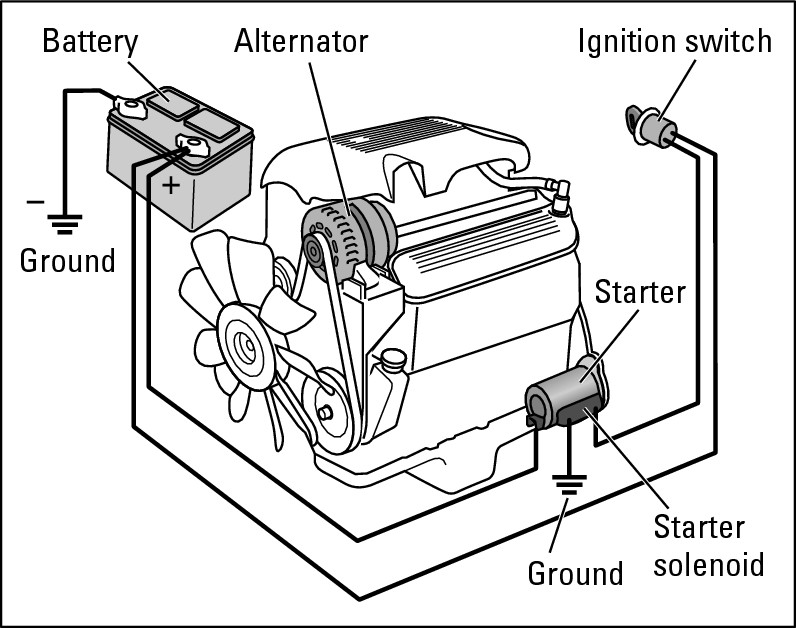
|
2. The starter makes the engine turn over (that’s the growling sound you hear before the engine starts running smoothly). Chapter 5 tells you exactly how it does this.
3. The electric current stops flowing to the starter but continues to flow through the charging system (which uses an alternator to generate power and charge the battery) and to the rest of the electrical system.
4. Now the fuel system comes into play (see Figure 4-3): If you drive a vehicle with an internal combustion engine (ICE), whether your vehicle is more than 20 years old or just 20 days old, has fuel-injection or a carburetor, it probably has the same basic parts in its fuel system with one exception: On modern vehicles, the fuel system — along with most other systems — is controlled by the ECU. Chapter 7 explores the fuel system in detail, and Chapter 8 tells you how to keep it in tune.
|
Figure 4-3: The fuel system. |

|
5. When the engine is running, fuel flows from the fuel pump (usually located inside the fuel tank at the rear of the vehicle) through the fuel filter, to the fuel injectors, into the intake manifold, and then into the combustion chamber.
6. Each pound of fuel is mixed with 14.7 pounds of air to form a vaporized mixture, like a mist. Because fuel is much heavier than air, this mixture works out to something like 1 gallon of fuel to 2,000 gallons of air (which is the equivalent of a gallon of gas to a roomful of air). In other words, your engine really runs on air, with a little fuel to help it!
7. The fuel/air mixture passes into the cylinders in your engine. A cylinder, as shown in Figure 4-4, is a hollow pipe with one open end and one closed end. Inside each cylinder is a piston, which fits very snugly and moves up and down. The piston moves up, trapping the fuel/air mixture in the upper part of the cylinder and compressing it into a very small space.
|
Figure 4-4: A cylinder and piston. |
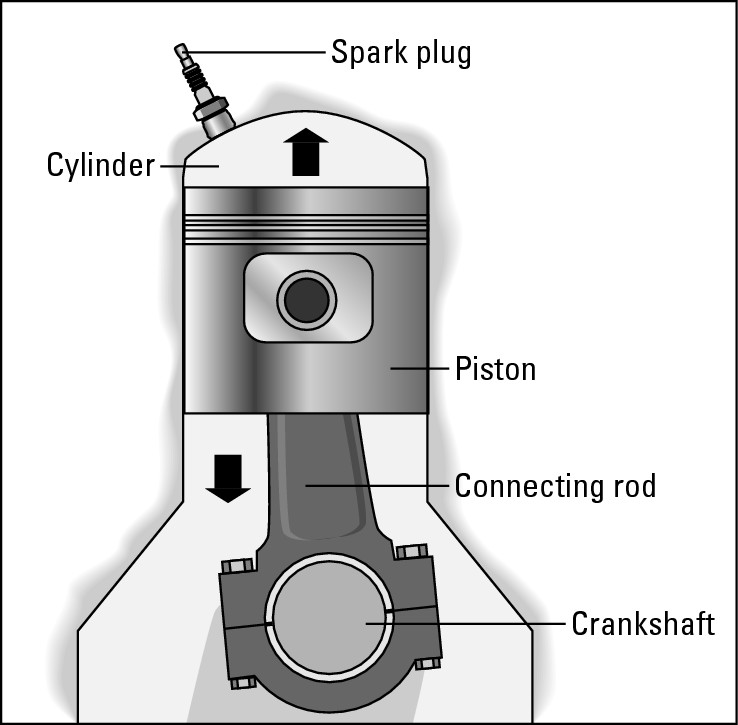
|
8. A spark from a spark plug ignites the fuel/air mixture, causing it to burn and expand rapidly.
9. This expansion of gases forces the piston back down again, with more power than when it went up.
10. Attached to the bottom of the piston is a connecting rod that’s attached to a crankshaft, which leads, eventually, to the drive wheels of your vehicle. As the piston and the connecting rod go up and down, they cause the crankshaft to turn. As shown in Figure 4-5, this is pretty much the same motion you use to pedal a bike: Your knee goes up and down while your foot pedals around and around.
|
Figure 4-5: The pistons and connecting rod move up and down to turn the crankshaft in circles. |

|
11. To the rear of the crankshaft is the transmission, called a transaxle on vehicles with front-wheel drive. If your vehicle has rear-wheel drive (see Figure 4-6), the transmission is under the floor ahead of the front seat. If it has a transverse engine and front-wheel drive (see Figure 4-7), the transmission is under the engine. On rear-engine vehicles, both the engine and the transmission are under the rear deck lid, where the trunk ordinarily is found.
|
Figure 4-6: Cutaway view of a car with rear-wheel drive. |

|
|
Figure 4-7: Cutaway view of a car with front-wheel drive. |
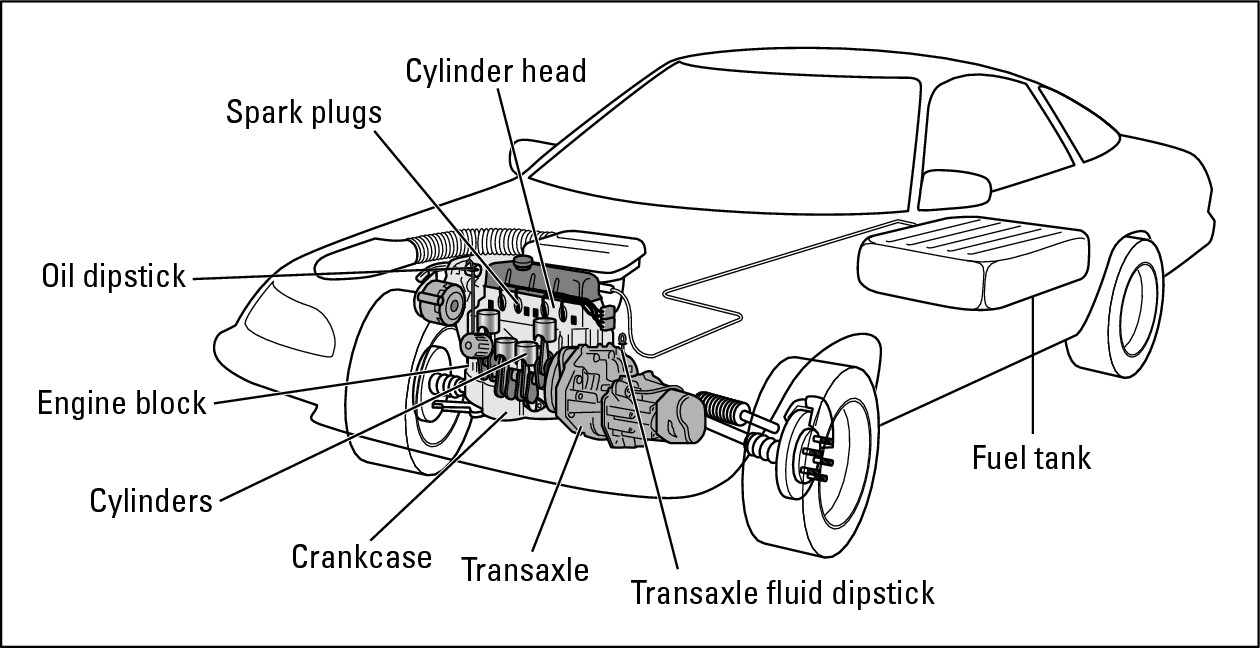
|
12. If your vehicle has a manual transmission, you’ll also find the clutch located between the crankshaft and the transmission. The clutch connects or disconnects the engine from the rest of the drive train. Because the parts are all stretched out in a row and easy to see, Figure 4-8 shows you the drive train on a vehicle with rear-wheel drive and a manual transmission. Remember, in a car with an automatic transmission, the clutch action is done automatically.
|
Figure 4-8: The drive train in a vehicle with rear-wheel drive and a manual transmission. |
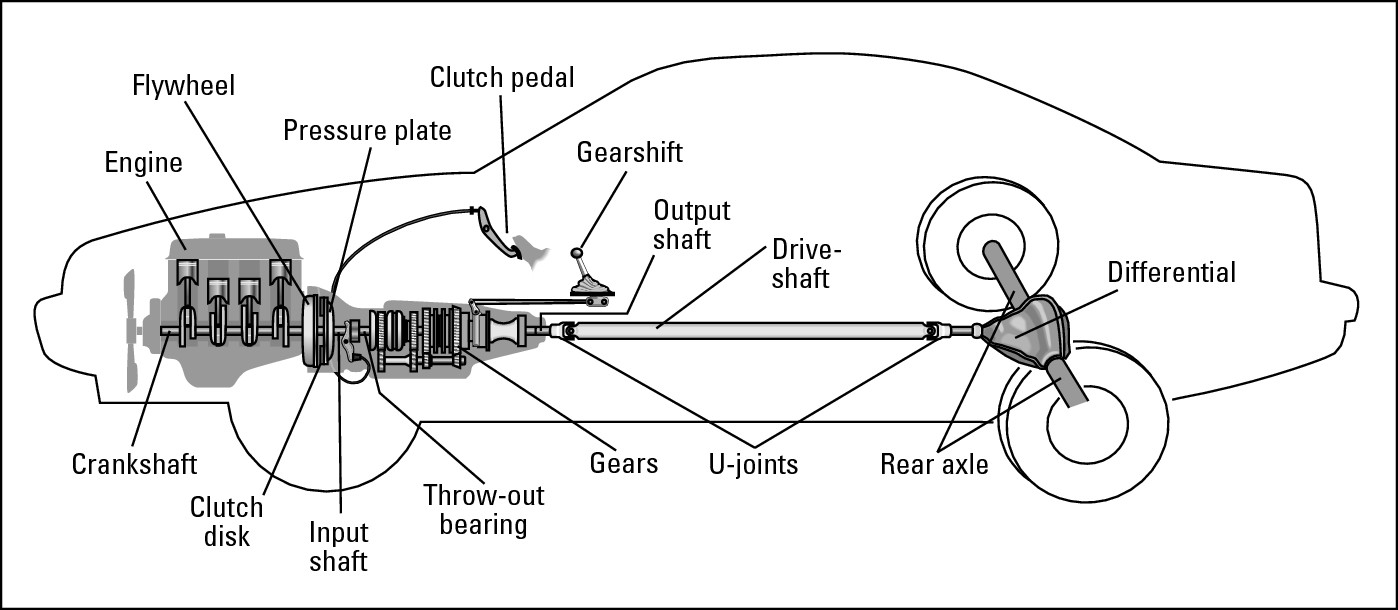
|
13. When you shift into Drive (or First, if you have a manual transmission), a set of gears causes the rest of the crankshaft (which is called the driveshaft after it leaves the transmission) to turn at a particular speed.
14. The driveshaft runs to the rear wheels of conventional rear-wheel-driven vehicles and ends in another set of gears called the differential. The differential turns the power of the engine and the transmission 90 degrees into the axles that connect to drive wheels of the vehicle. Because on most vehicles the axle is set at right angles to the driveshaft, you can see that the differential is really changing the direction of the power so that the drive wheels can turn.
Chapter 18 looks at all types of drive trains and transmissions in detail, including all-wheel drive, four-wheel drive, and continuously variable transmissions (CVT). In that chapter, Figure 18-3 shows you how the differential changes the direction of the power 90 degrees.

Vehicles with front-wheel drive or with rear engines don’t require a long driveshaft because the power source is located right between the drive wheels that drive the vehicle. On these vehicles, the transmission and the differential are combined into a single unit called the transaxle, which connects directly to provide power to the drive wheels. Figure 4-9 shows you how power flows through a transaxle.
|
Figure 4-9: The flow of power through a transaxle. |
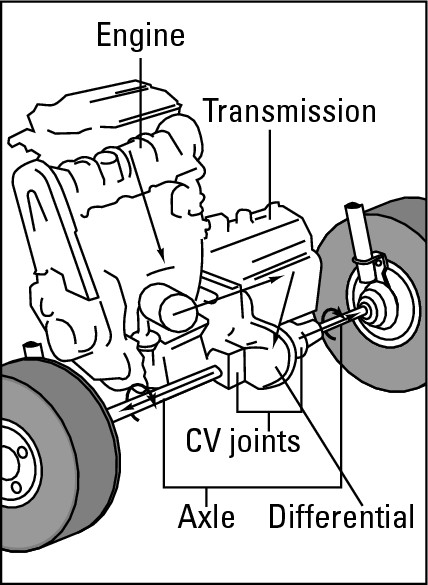
|
15. The drive wheels turn and push the vehicle forward (or backward), and off you go. And all you had to do was turn on the ignition and step on the gas!
What Makes Your Vehicle Run?
The following sections take a closer look at what various automotive systems do to keep your vehicle moving happily down the road. Because these systems work simultaneously and just keep on doing the same thing over and over, there’s no need to take them step-by-step.
The ignition system
After your engine has started running, the ignition system continues to provide high voltage to the spark plugs so that they can provide the spark that causes the fuel/air mixture to burn. To do so on modern vehicles with distributorless ignition systems, the ECU or a dedicated ignition control module (ICM) receives signals from sensors and controls when the spark plugs fire and ignite the fuel/air mixture in the cylinders, which provides the power to drive the engine. Figure 4-10 shows a distributorless ignition system.
|
Figure 4-10: The distributorless electronic ignition system. |
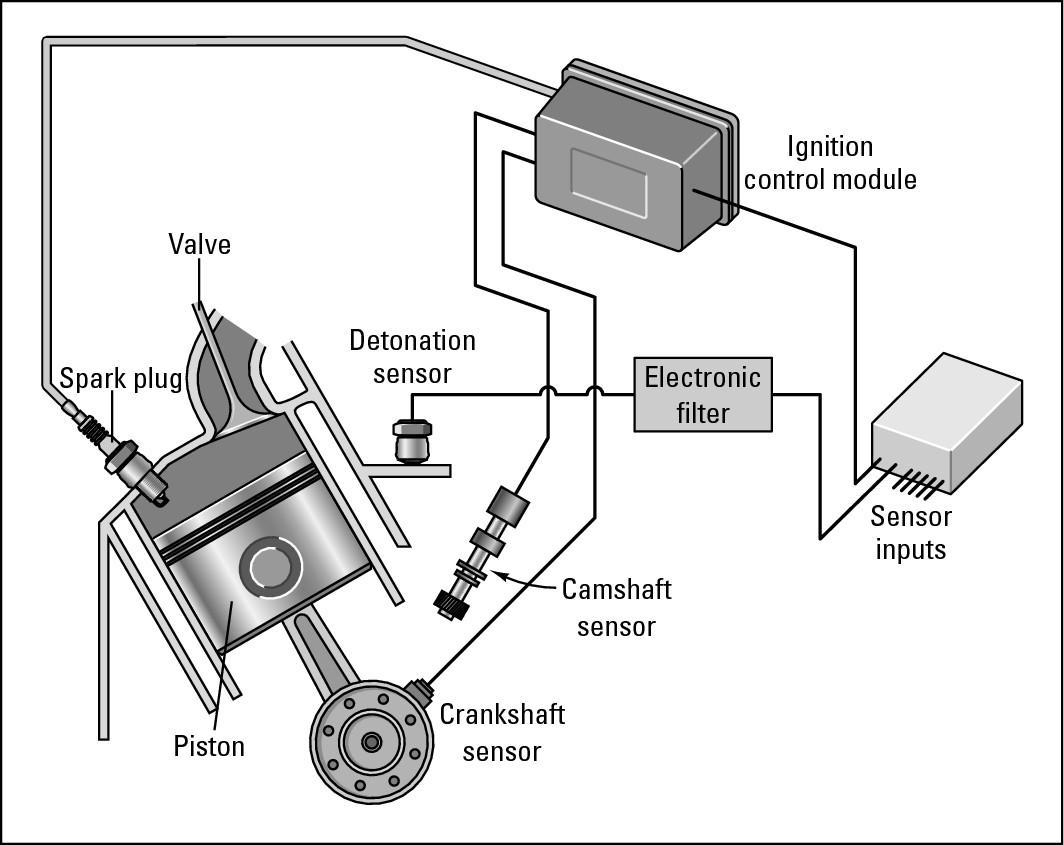
|
Chapter 5 examines both distributorless electronic ignition systems and ones with distributors and explores the rest of the electrical system and subsystems in greater detail. Chapter 6 shows you how to keep the various parts of the electrical system working together in harmony.
The cooling system
The combustion of fuel and air takes place at around 4,500°F, so the excess heat must be removed or the engine would melt down. This is accomplished by the circulation of liquid coolant through water jackets that surround the cylinders which carry the heat to the radiator, which dissipates it. A water pump keeps the coolant circulating while a cooling fan keeps the air flowing through the radiator when you’re idling in traffic. You can see the entire cooling system in Figure 4-11. Modern vehicles also have a transmission cooler to keep the transmission from overheating.
Chapter 11 explores the cooling system in greater detail, and Chapter 12 shows you how to do simple jobs like flushing the system and replacing the coolant. It also shows you what to do if your vehicle overheats.
|
Figure 4-11: The cooling system. |

|
The lubrication system
Oil constantly circulates through your engine to keep its moving parts (pistons, connecting rods, crankshaft, and the like) lubricated to move freely and to reduce the friction that causes your engine to heat up. An oil pump keeps the oil circulating, and an oil filter keeps it clean. Figure 4-12 shows you what a lubrication system looks like.
|
Figure 4-12: Oil cools the engine as part of the lubrication system. |
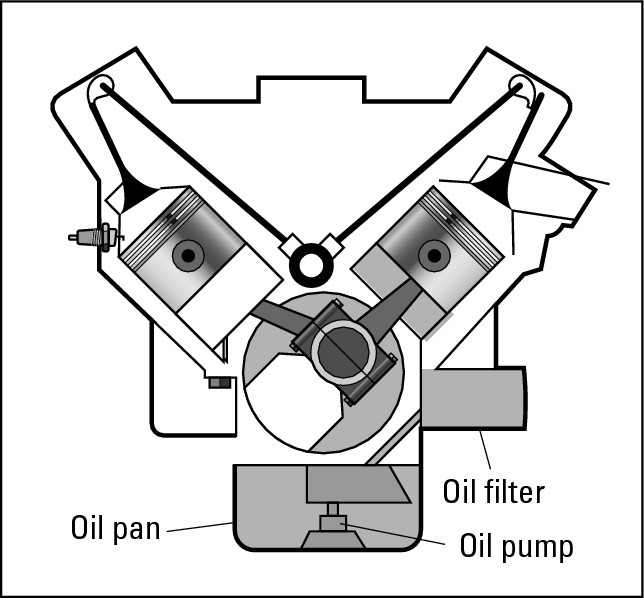
|
Chapter 13 tells you what oil does and how to change your oil and oil filter. For a close-up look at various steering and suspension systems, see Chapter 16.
The exhaust system
The exhaust system, shown in Figure 4-13, is your vehicle’s waste-disposal system. Exhaust gases from the burnt fuel/air mixture that was ignited in the cylinders pass through exhaust pipes to the tailpipe at the rear of the vehicle.

A muffler controls the noise of the escaping gases; if it fails, you can get a ticket, probably for disturbing the peace! A muffler also has an effect on the pressure required to pass the exhaust gases through it: It creates the “back pressure” that the engine requires to run efficiently and affects the temperature and therefore the efficiency of the catalytic converter.
You get a closer look at all the parts of the exhaust system in Chapter 7.
|
Figure 4-13: The exhaust system. |
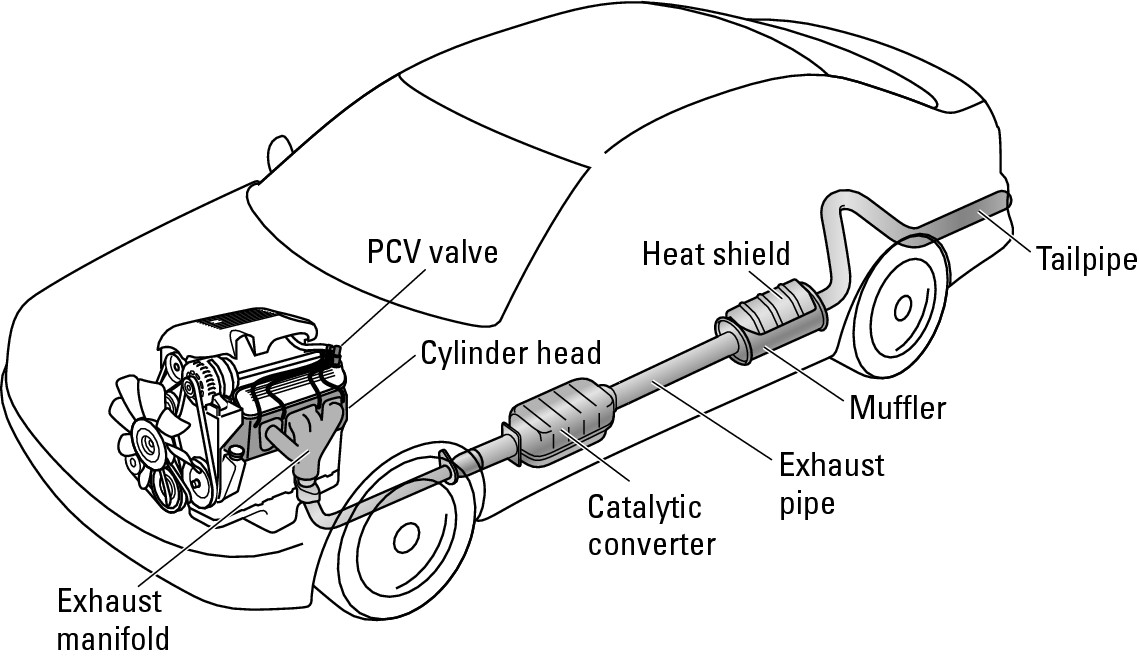
|
What Makes Your Vehicle Stop?
Still with me? Good! Now all you need to know is what goes on when it’s time for your vehicle to stop. This is the job of the brake system (but you knew that, right?).
Today, vehicles not only have hydraulic brakes — many have electronic brake systems, as well. Most modern vehicles come with anti-lock braking systems (ABS) that can prevent skids in slippery conditions and keep you in control of your vehicle until you can stop safely. Electric vehicles (EV) and hybrids feature regenerative braking systems that generate electric current to drive their electric motors.
For details on all the various braking systems and parts, including power brakes and parking brakes, check out Chapter 14. Chapter 15 has instructions on checking your brakes and doing other related jobs, and Chapter 10 has a section on regenerative braking systems.
Figure 4-14 shows you the major parts of a system with drum brakes at the rear wheels and disc brakes up front. Use it as you review the steps that follow, which give you a basic view of how a brake system operates.
|
Figure 4-14: A brake system. |

|
1. To stop your vehicle, you step on the brake pedal.
2. The brake pedal pushes against a piston in a cylinder located under the hood. This part is called the master cylinder, and it’s filled with a liquid called brake fluid.
3. When the piston in the master cylinder is pushed by your brake pedal, it forces the brake fluid out of the master cylinder into tubes called brake lines, which run to each wheel. (A power brake booster located between the brake pedal and the master cylinder increases the force applied to the piston in the master cylinder so that it takes less effort to stop your vehicle.)
4. Each wheel has either a disc brake or a drum brake. To keep it simple, I just look at disc brakes here. (Drum brakes work on the same general principles, as I explain in Chapter 14.) A disc brake is composed of a flat, iron disc (surprise!) sandwiched between a pair of brake pads by a caliper, as shown in Figure 4-15. The caliper contains one, two, or four pistons that force the friction material on the pads against the disc.
|
Figure 4-15: A disc brake. |
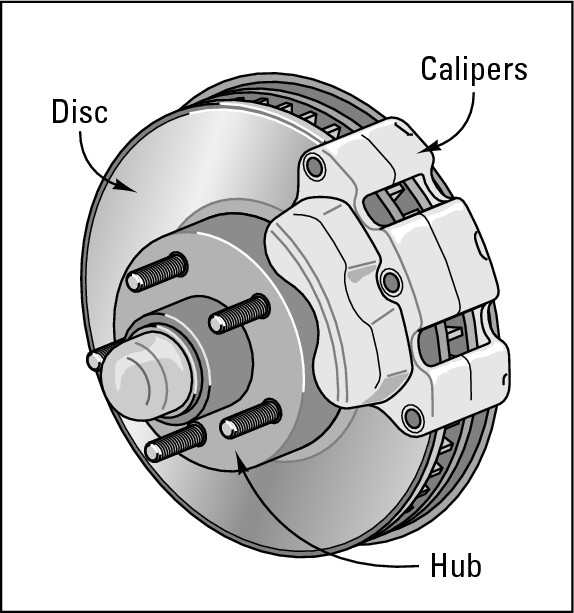
|
5. Brake pads located in the caliper on both sides of the disc grab the disc and force it to stop turning. This forces the wheel to stop turning. When the wheels stop turning, the vehicle comes to a stop.
6. When you take your foot off the brake pedal, the whole process is reversed: The brake pads release their hold on the disc, the fluid moves back up the brake lines to the master cylinder, and the wheels can turn freely again.

Now that you have a general picture of how the various systems in your vehicle work together, don’t stop here! The rest of this book goes into detail about each of the systems outlined in this chapter and what you can do to repair them and keep them running smoothly. Be sure to read the chapter on how a particular system works before tackling the related instructional chapter.